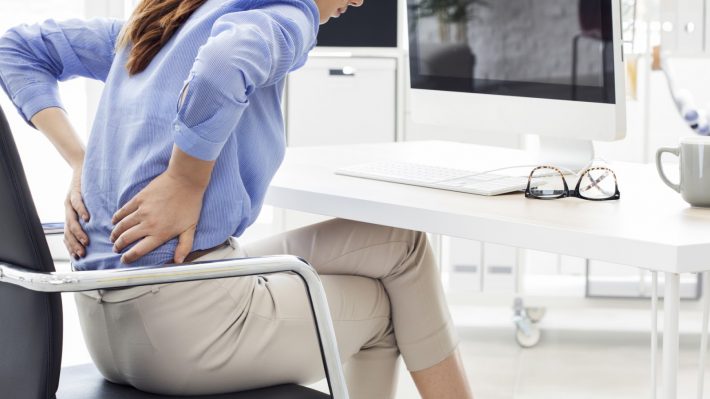
In efforts to avoid the ill effects that come with sitting long hours at a desk job (“sitting is the new smoking” has become a common saying), people are increasingly taking to the idea of standing rather than sitting down. Upon the discovery that sitting for 6 to 10 hours a day can cause back pain and other health problems, standing desks have become quite popular.
The switch to a standing desk can be motivated by many ailments, but one of the most common is back pain – and specifically lower back pain.
Today, we ask the question: “What’s the effect of standing desks on back pain? We take a look at the facts in order to answer this common query.
The negative effects of sitting
The average person sits more than 6 hours of the day. It’s second nature. Many of us go from sleeping in a bed to sitting at a desk, with very little movement in between. But, with this lifestyle come a few worrisome statistics.
A major long-term health study looked at the sitting habits of over 7,000 men between ages 20 and 89. Inspecting their sitting habits and following up over 20 years, it was discovered that:
- Sitting for more than 4 hours a day increases risk of dying from any cause by 40%.
- And when the study looked at men who sat at work and in the car during a commute, the chance of experiencing a heart attack increased by more than 60%.
Now, do keep in mind that this study was conducted on men who sat at work, in the car, and watched at least some television. But the data is unsettling – and these are all very common daily activities.
Beyond the study, here are a few known effects of sitting for long hours:
- Increased blood pressure
- Increased load on lower back and neck
- Poor posture
- Tightened muscles – lower back, neck, hips
Are you reading this slouched at your desk? Note whether or not you’re experiencing any lower or mid back pain.
Bad Posture = More Problems
Bad posture is a sneaky saboteur – it can be comfortable and almost second nature to slouch over your desk. As you work, you subconsciously begin to lose strength and flexibility in your back muscles.
Without becoming aware of too many initial signals, prolonged periods of poor posture can gradually tighten your lower and mid back muscles, eventually causing them to seize up and get sore.
The good news is, There are ways to improve posture. And while being constantly aware of your posture isn’t always possible, you can help enforce good posture by standing.
Introducing: the standing desk.
What can the standing desk do for you?
It’s hard to slouch when your computer is at eye level. The standing desk essentially removes the temptation to hunch your back.
Here are some things the standing desk can do for you:
- Increase alertness
- Promote productivity
- Improve postural strength
- Ease back pain
- Stretch tight muscles
The standing desk can strengthen and improve a lot of lower back issues.
However, the standing desk isn’t the answer to eliminating all lower back pain. Standing puts different pressures on your muscles and joints. This can prove to be tiring, or even harmful in its own right if you stand for too long or with poor posture.
If you suffer from an over-arched lower back, standing can actually make the condition worse. Standing will put pressure on the lower back area and increase your pain levels.
So what is the answer to back pain? If the standing desk isn’t the cure, then what is?
The cure for Lower Back Pain
There is no concrete cure, but there are preventative measures that you can put in place to improve the strength of your lower back muscles and relieve the stress that’s causing you pain.
The standing desk is just one preventative idea to improve your posture and lower back strain associated with sitting. But it’s not to be used as a solution.
Look for a happy medium that fits- in with you, which promotes an active lifestyle. Consider regular flexibilty and strengthening exercises and aerobic fitness activities that helps condition your core and girdle muscles. Consider using a standing desk periodically and ensure that you take regular work breaks.
Lastly, consult your physio. Your physio will be able to assess and advise you on the best preventative treatment for you.
For more information on the standing desk see this article – Will A Standing Desk Fix My Back Pain
Give it a Go
If you’re curious in the standing desk, then give it a go.
Using it for an hour a day will give your back a rest and work to improve your posture.
If you’re experiencing lower back pain, we hope this blog has given you some perspective. If you have any further questions or need help regarding back pain, we hope you keep Morley Physiotherapy Centre in mind.
Phone: (08) 9375 3900
Email: admin@morleyphysio.com.au
Disclaimer: Provision of education and research information only – always seek professional advice
This website is presented by Morley Physiotherapy and associated parties, for the purpose of disseminating health information free of charge for the benefit of the public. This website is not a substitute for independent professional advice. Nothing contained in this website is intended to be used as medical advice and it is not intended to be used to diagnose, treat, cure or prevent any disease, nor should it be used for therapeutic purposes or as a substitute for your own health professional’s advice
